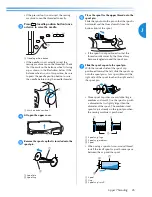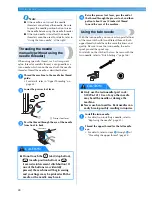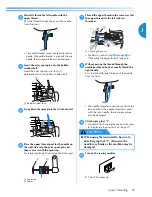
GETTING READY
———————————————————————————————————————————————————
14
Changing the Machine Settings
Various sewing machine operations and sewing settings can be changed.
Changing the settings
The general procedure for changing machine settings
is described below.
1
Turn on the sewing machine.
X
The LCD comes on.
2
Press
(settings key) in the operation
panel.
X
The settings screen appears.
3
Press
,
,
and
(arrow keys) until
the stitch or machine attribute that you wish
to set is selected.
4
Press
(OK key).
X
A screen containing settings for the selected
attribute appears.
5
Press
,
,
and
(arrow keys) until
the desired setting is selected.
X
The setting is changed.
6
Press
(OK key).
X
The initial stitch screen appears again.
Summary of Contents for 885-S61
Page 50: ...GETTING READY 44 ...
Page 72: ...SEWING BASICS 66 ...
Page 152: ...APPENDIX 146 Z zipper stitching 85 89 ...
Page 153: ......
Page 154: ......
Page 155: ......






























